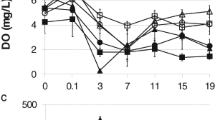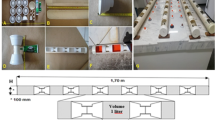Abstract
As compared to other aquatic organism groups, relatively few studies have been conducted so far evaluating the toxicity of pesticides to amphibians. This may at least partly be due to the fact that regulations for registering pesticides usually do not require testing amphibians. The sensitivity of amphibians is generally considered to be covered by that based on toxicity tests with other aquatic organisms (e.g. fish) although the impact of a pesticide on amphibians may be very different. In the present study, acute and chronic laboratory tests were conducted to evaluate the acute and chronic toxicity of abamectin (as Vertimec® 18EC) to bullfrog (Lithobates catesbeianus) tadpoles. Acute tests were conducted at two tadpole stages (Gosner stage 21G and 25G) and avoidance tests were also conducted with stage Gosner stage 21G tadpoles. Calculated acute toxicity values were greater than those reported for standard fish test species, hence supporting the use of fish toxicity data as surrogates for amphibians in acute risk assessments. Given the limited number and extent of available amphibian toxicity studies, however, research needs to increase our understanding of pesticide toxicity to amphibians are discussed.




Similar content being viewed by others
References
Aldenberg T, Jaworska JS (2000) Uncertainty of hazardous concentrations and fraction affected for normal species sensitivity distributions. Ecotoxicol Environ Safe 46:1–18
Araújo CVM, Shinn C, Vasconcelos AM, Ribeiro R, Espíndola ELG (2014a) Preference and avoidance responses by tadpoles: the fungicide pyrimethanil as a habitat disturber. Ecotoxicology 23:851–860
Araújo CVM, Shinn C, Moreira-Santos M, Lopes I, Espíndola ELG, Ribeiro R (2014b) Copper-driven avoidance and mortality in temperate and tropical tadpoles. Aquat Toxicol 146:70–75
Berrill M, Bertram S, McGilliray L, Kolohon M, Pauli B (1994) Effects of low concentrations of forest-use pesticides on frog embryos and tadpoles. Environ Toxicol Chem 13:657–664
Boone MD, Bridges CM, Rothermel BB (2001) Growth and development of larval green frogs (Rana clamitans) exposed to multiple doses of an insecticide. Oecologia 129:518–524
Bridges CM (2000) Long-term effects of pesticide exposure at various life stages of the southern leopard frog (Rana sphenocephala). Arch Environ Contam Toxicol 39:91–96
Campana MA, Panzeri AM, Moreno VJ, Dulout FN (2003) Micronuclei induction in Rana catesbeiana tadpoles by the pyrethroid insecticide lambda-cyhalothrin. Genet Mol Biol 26:99–103
Chapman PM (2002) Integrating toxicology and ecology: putting the ‘‘eco’’ into Ecotoxicology. Mar Pollut Bull 44:7–15
Clements C, Ralph S, Petras M (1997) Genotoxicity of select herbicides in Rana catesbeiana tadpoles using the alkaline single-cell gel DNA electrophoresis (Comet) assay. Environ Mol Mutagen 29:277–288
Costa MJ, Monteiro DA, Oliveira-Neto AL, Rantin FT, Kalinin AL (2008) Oxidative stress biomarkers and heart function in bullfrog tadpoles exposed to Roundup Original®. Ecotoxicology 17:153–163
Dornelles MF, Oliveira GT (2014) Effect of atrazine, glyphosate and quinclorac on biochemical parameters, lipid peroxidation and survival in bullfrog tadpoles (Lithobates catesbeianus). Arch Environ Contam Toxicol 66:415–429
European Commission (EC) 2006. Draft Assessment Report (DAR)– Public Version– Initial risk assessment provided by the Rapporteur Member State the Netherlands for the existing active substance abamectin of the third stage (part A) of the review programme referred to in Article 8(2) of Council Directive 91/414/EEC
EFSA (2013) Guidance on tiered risk assessment for plant protection products for aquatic organisms in the edge-of-field surface waters. EFSA J 11:3290
Fordham CL, Tessari JD, Ramsdell HS, Keefe TJ (2001) Effects of malathion on survival, growth, development, and equilibrium posture of bullfrog tadpoles (Rana catesbeiana). Environ Toxicol Chem 20:179–184
Fryday S, Thompson H (2012) Toxicity of pesticides to aquatic and terrestrial life stages of amphibians and occurrence, habitat use and exposure of amphibian species in agricultural environments. EFSA (European Food Safety Authority) Supporting Publications 2012:EN-343
Fuentes L, Moore LJ, Rodgers JH Jr, Bowerman WW, Yarrow GK, Chao WY (2011) Comparative toxicity of two glyphosate formulations (original formulation of Roundup® and Roundup WeatherMAX®) to six North American larval anurans. Environ Toxicol Chem 30:2756–2761
Gervasi SS, Urbina J, Hua J, Chestnut T, Relyea RA, Blaustein AR (2013) Experimental evidence for American bullfrog (Lithobates catesbeianus) susceptibility to chytrid fungus (Batrachochytrium dendrobatidis). EcoHealth 10:166–171
Giovanelli JGR, Haddad CFB, Alexandrino J (2009) Predicting the potential distribution of the alien invasive American bullfrog (Lithobates catesbeianus) in Brazil. Biol Invasion 10:585–590
Gosner KL (1960) A simplified table for staging anuran embryos and larvae with notes on identification. Herpetologica 16:183–190
Greulich K, Pflugmacher S (2003) Differences in susceptibility of various life stages of amphibians to pesticide exposure. Aquat Toxicol 65:329–336
Gunderson MP, Veldhoen N, Skirrow RC, Macnab MK, Ding W, van Aggelen G, Helbing CC (2011) Effect of low dose exposure to the herbicide atrazine and its metabolite on cytochrome P450 aromatase and steroidogenic factor-1 mRNA levels in the brain of premetamorphic bullfrog tadpoles (Rana catesbeiana). Aquat Toxicol 102:31–38
Hamilton MA, Russo RC, Thurston RV (1977) Trimmed spearman-karber method for estimating median lethal concentrations in toxicity bioassays. Environ Sci Technol 11:714–719
Hammond JI, Jones DK, Stephens PR, Relyea RA (2012) Phylogeny meets ecotoxicology: evolutionary patterns of sensitivity to a common insecticide. Evol Appl 5:593–606
Jones DK, Hammond JI, Relyea RA (2011) Competitive stress can make the herbicide Roundup® more deadly to larval amphibians. Environ Toxicol Chem 30:446–454
Lumaret JP, Errouissi F, Floate K, Römbke J, Wardhaugh K (2012) A review on the toxicity and non-target effects of macrocyclic lactones in terrestrial and aquatic environments. Curr Pharm Biotechnol 13:1004–1060
Moore LJ, Fuentes L, Rodgers JH Jr, Bowerman WW, Yarrow GK, Chao WY, Bridges WC Jr (2012) Relative toxicity of the components of the original formulation of Round® to five North American anurans. Ecotoxicol Environ Safe 78:128–133
Ortiz-Santaliestra ME, Marco A, Fernández MJ, Lizana M (2006) Influence of developmental stage on sensitivity to ammonium nitrate of aquatic stages of amphibians. Environ Toxicol Chem 25:105–111
Ossana NA, Castane PM, Poletta GL, Mudry MD, Salibian A (2010) Toxicity of waterborne copper in premetamorphic tadpoles of Lithobates catesbeianus (Shaw, 1802). Bull Environ Contam Tox 84:712–715
Pough FH, Janis CM, Heiser JB (2008) A vida dos vertebrados, 4th edn. Atheneu Editora, São Paulo
Raftery TD, Volz DC (2015) Abamectin induces rapid and reversible hypoactivity within early zebrafish embryos. Neurotoxicol Teratol 49:10–18
Relyea RA (2004) Synergistic impacts of malathion and predatory stress on six species of North American tadpoles. Environ Toxicol Chem 23:1080–1084
Relyea RA (2005) The lethal impacts of roundup and predatory stress on six species of North American tadpoles. Arch Environ Contam Toxicol 48:351–357
Relyea RA, Jones DK (2009) The toxicity of Roundup Original Max® to 13 species of larval amphibians. Environ Toxicol Chem 28:2004–2008
Rohr JR, Raffel TR, Hall CA (2010) Developmental variation in resistance and tolerance in a multi-host–parasite system. Funct Ecol 24:1110–1121
Schiesari L, Werner EE, Kling GW (2009) Carnivory and resource-based niche differentiation in anuran larvae: implications for food web and experimental ecology. Freshw Biol 54:572–586
Schuytema GS, Nebeker AV (1996) Amphibian toxicity data for water quality criteria chemicals. EPA/600/R-96/124. U.S. Environmental Protection Agency, National Health and Environmental Effects Research Laboratory, Western Ecology Division, Corvallis, Oregon, USA
Schuytema GS, Nebeker AV (1998) Comparative toxicity of diuron on survival and growth of Pacific treefrog bullfrog, red-legged frog, and African clawed frog embryos and tadpoles. Arch Environ Contam Toxicol 34:370–376
Schuytema GS, Nebeker AV, Griffis WL, Wilson KN (1991) Teratogenesis, toxicity, and bioconcentration in frogs exposed to dieldrin. Arch Environ Contam Toxicol 21:332–350
Sparling DW, Linder G, Bishop C, Krest S (2010) Ecotoxicology of amphibians and reptiles. SETAC/Taylor & Francis, Boca Raton
Us EPA (2004) Overview of the ecological risk assessment process in the Office of Pesticide Programs. U.S. Environmental Protection Agency, US EPA, Washington, USA
Van Vlaardingen P, Traas TP, Wintersen AM, Aldenberg T (2004) ETX 2.0. A program to calculate hazardous concentrations and fraction affected, based on normally distributed toxicity data. RIVM Report No. 601501028/2004. National Institute of Public Health and the Environment (RIVM), Bilthoven, the Netherlands
Weltje L, Simpson P, Gross M, Crane M, Wheeler J (2013) Comparative acute and chronic sensitivity of fish and amphibians: a critical review of data. Environ Toxicol Chem 32:984–994
Wislocki PG, Grosso LS, Dybas RA (1989) Environmental aspects of abamectin use in crop protection. In: Campbell WC (ed) Ivermectin and abamectin. Springer, New York, pp 182–200
Acknowledgments
The present study was funded by the Brazilian government through a PhD scholarship for the first author (CNPq) and the Special Visiting Researcher program (MEC/MCTI/CAPES/CNPq/FAPs reference 402392/2013-2). The authors are also indebted to FCT (Portugal, reference SFRH/BPD/74044/2010) and SENESCYT (Secretaría de Educación Superior, Ciencia, Tecnología e Innovación, Ecuador) for scholarships for CVM Araújo and to colleagues from the Ecotoxicology Laboratory of the Centro de Energia Nuclear da Agricultura (CENA; Valdemar Tornisielo and Rodrigo Pimpinato) for chemical analysis of abamectin and to the staff at NEEA/CRHEA for their technical assistance.
Author information
Authors and Affiliations
Corresponding author
Ethics declarations
Conflict of Interest
The authors declare that they have no conflict of interest.
Ethical approval
All applicable international, national, and/or institutional guidelines for the care and use of animals were followed.
Rights and permissions
About this article
Cite this article
Vasconcelos, A.M., Daam, M.A., dos Santos, L.R.A. et al. Acute and chronic sensitivity, avoidance behavior and sensitive life stages of bullfrog tadpoles exposed to the biopesticide abamectin. Ecotoxicology 25, 500–509 (2016). https://doi.org/10.1007/s10646-015-1608-4
Accepted:
Published:
Issue Date:
DOI: https://doi.org/10.1007/s10646-015-1608-4




